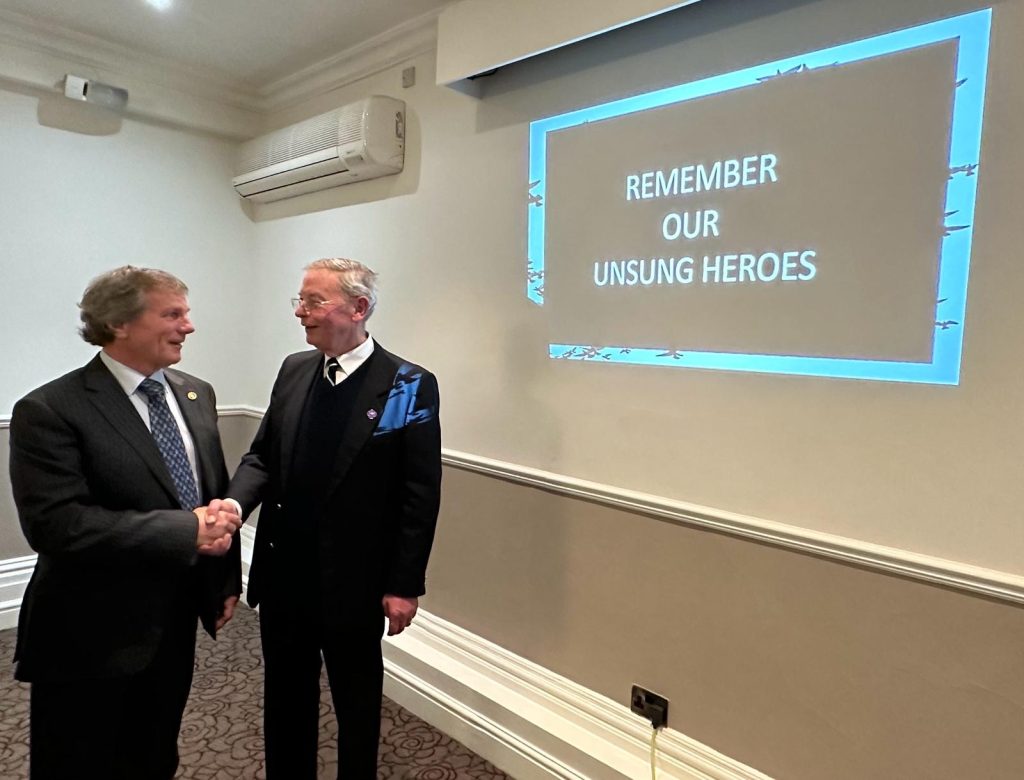SALISBURY ROTARY LEARNS ABOUT ‘ANIMALS IN WAR
Members of Salisbury Rotary Club gave a warm welcome to guests and to Colonel Philip Whitemore, President of the Salisbury Branch of The Royal Signals Association, as their the guest speaker, with his topic being – ‘Unsung Heroes – Animals in War’.

We have all heard about horses in war – particularly through the novel, War Horse, by Michael Morpurgo and the subsequent film and stage play, and of course pigeons for carrier post and sniffer dogs for bombs etc.
But Philip’s talk was about much more than that, taking us back in history and recounting the sometimes heart-rending stories of the horses, mules, pigeons, dogs, and even cats and the occasional goat and pig and even a dolphin that served the Armed Forces in wartime. The period he covered was from ancient times – reflecting on Alexander the Great and Hannibal and their use of elephants, the horses in the Bayeux Tapestry and even the Red Indians in America – but mainly through WWI, WWII, before touching on the the Cold War and the recent conflicts in the Middle East and finally to modern times – remembering the continued use of dogs and cats in search and rescue and in bomb and mine clearances and as mascots, and the Household Cavalry and of course, the ravens in the Tower of London.
We are renowned as an animal loving nation and this is reflected in the fact that the RSPCA was founded in 1824, sixty years before the NSPCC in 1884. And indeed, veterinary hospitals were being set up in the battle fields as long ago as in WW1.
But, what a price animals have had to pay. Just to give an example or two:
- in the Boer War (1899 – 1902), 326,073 horses and 51,000 mules died
- in WW1, an estimated 20 million people died, as well as 9 million horses, dogs, camels and pigeons.
- in 1939 after the outbreak of WW2, 250,000 dogs and cats were culled due to food shortages.
- 100,000 racing pigeons served during WW I and over 200,000 during the second world war.
- 3 million horses and dogs were used by Germany with 750,000 dying.
Horses and mules were primarily used for cavalry and transport.
Elephants were also used for transport – particularly in Burma and India.
Dogs were used for search and rescue, as ammunition carriers, bomb and mine clearances and as mascots. Some were parachuted in to battlefields to carry medicines.
Cats were also used as mascots but also to clear trenches of rats and mice.
Pigeons were used to carry messages and cameras and film, and were based in the trenches, on tanks, aircraft and boats – every bomber, and every ship on DDay had 2 pigeons on board (to preserve radio silence on landing); and were used by the Special Operations Executive (SOE). One pigeon (Cher Ami) was awarded the French Croix de Guerre.
And of course, many animals were awarded the Dickin Medal (equivalent to the Victoria Cross) – The Medal has been awarded 75 times since inception in 1943 plus 1 Honorary PDSA Dickin Medal. The recipients comprise 38 dogs, 32 pigeons, 4 horses and 1 cat.
A truly fascinating, educational and informative talk – just what a good speaker should provide – so many thanks to Philip.
News
- SALISBURY ROTARY CLUB WELCOMES SPIRE HOMECARE AS ITS FIRST CORPORATE MEMBER
President of the Rotary Club of Salisbury, Peter Mitchell, was… - CLARENDON PALACE COMES TO LIFE AT SALISBURY ROTARY CLUB
Salisbury Rotary Club members were enthralled at a recent meeting… - SALISBURY ROTARY INSTALLS ANOTHER LIFE SAVING DEFIBRILLATOR
Salisbury Rotary Club was delighted to fund the installation of… - SALISBURY ROTARY YOUNG MUSICIANS WINNERS
Godolphin School was the venue for the Rotary Wessex District… - SALISBURY ROTARY CLUB WELCOMES A NEW MEMBER
President of the Rotary Club of Salisbury, Peter Mitchell, was… - View all News
Events
- Salisbury Rotary Supporting The Clarendon Marathon in 2022
Full Marathon / Half Marathon / Relay (x4) /… - View all Events